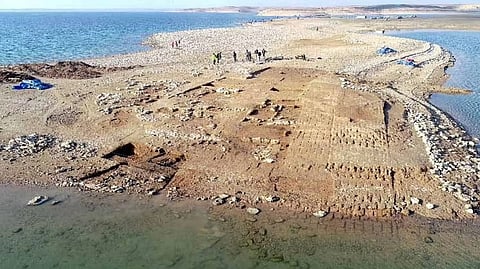

Southern Iraq has been suffering from extreme drought for months. Since December, large amounts of water have been diverted from the Mosul Dam, Iraq’s most important water reservoir, to prevent harvests from drying out. Due to the low water level, the remains of a 3,400-year-old city that disappeared decades ago emerged on the edge of the reservoir. “I saw on satellite images that the water level was falling but it wasn’t clear when the water would rise again. So, we had an unknown window of time,” says German archaeologist Ivana Puljiz, a junior professor at the University of Freiburg. But archaeologists knew that the site — known as Kemune — was interesting. They had been there before.
So, Puljiz got together with Hasan Ahmed Qasim, a Kurdish archaeologist and director of the Kurdistan Archaeology Organization, and Peter Pfälzner, a German archaeology professor at the University of Tübingen, to carry out a spontaneous rescue excavation.
They quickly put together a team of German and Kurdish archaeologists to uncover and document as much of the large site as they could. The team surveyed the Bronze Age city for seven weeks in January and February 2022 before it was completely flooded again. During a similar dry phase in 2018, the researchers had discovered a fortress-like palace located nearby on a small hill. It was bordered by a large terrace wall. At the time, Ivana Puljiz’s team found the remains of wall paintings in bright red and blue tones, thought to be a typical feature of such palaces. The fact that the pigments were preserved despite the flooding was “an archaeological sensation,” Puljiz told DW after their 2022 visit to the site.
“Of course we had high hopes. Based on the things we had found in 2018, we knew that this site could bring interesting findings. But we didn’t know what exactly we would find [this time],” said Puljiz.
The team was not disappointed: During this year’s excavation, the archaeologist said they were able to uncover other large buildings, such as a massive fortification with a wall and towers that surrounded the city. The researchers’ discovery of a large, multi-story warehouse full of supplies was particularly exciting.
“The sheer size of this building alone shows that it had to have housed an enormous amount of goods. And these goods had to be produced and brought there first,” said Puljiz. It suggests the city obtained its supplies from a surrounding area it controlled.
Puljiz said their initial findings suggested the extensive city complex could be ancient Zachiku, an important center in the Mitanni empire (circa 1550 to 1350 BC). Zachiku controlled large parts of northern Mesopotamia and Syria. However, not much is known about ancient Zachiku. “There are very, very few mentions of this city name in other sources, so we are only now bringing new knowledge to light about it,” Puljiz said.
The walls and foundations of the building appear to be in surprisingly good condition, said Puljiz, despite their being made of unfired adobe bricks that have been under water for decades.
It’s possible that a massive earthquake that struck the city around 1350 BC helped preserve those walls — when the building was destroyed and the rubble fell, it may have covered the lower parts of the wall, thereby preserving them.
Are you in Chennai? Then click here to get our newspaper at your doorstep!
Visit news.dtnext.in to explore our interactive epaper!
Download the DT Next app for more exciting features!
Click here for iOS
Click here for Android